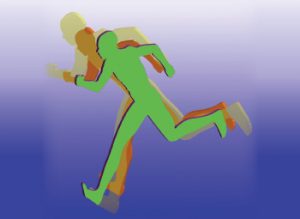My traveling suitcase always includes my trusty running shoes. I’ve met the nicest people and pets on foot while on side streets and country lanes, both simply off-map for a tour bus. Cardio benefits aside, I enjoy scenery along the way. I can run any time, anywhere, and in (almost) any weather—and I’ve done it. Running assuages the guilt factor arising from a sudden surge in gourmet cuisine and accompanying beverages.
I regularly mix up my workouts with cycling, riding a very large horse, practicing yoga, doing the “machine” circuit at the gym, and the occasional Zumba class—when I’m in the “herd mentality.” Still, running has remained my loyal friend since my late teens. I ran in the scorching heat growing up in Charlotte, N. C. (stubbornly and not safe) and around the reservoir in Central Park when I lived on 86th St. in New York City. I ran in the cold squalls while residing in Auckland, New Zealand, in the deep snow in Denver, Col. and now, I trot along the powdery beaches in Orange County, Calif.

Cruisin’ for a…
On the now-docked Queen Elizabeth II, I jogged around the “nearly” oval deck daily in blustering, often dangerous winds. I trudged up the stairs at the bridge, then back down, dodging intrepid walkers with canes who wondered why I was making such an effort. The answer was easy: truly amazing food. I still gained five pounds. I lost them.
A brand new study this week from the Univ. of New Hampshire found that runners over the age of 60 are the fastest-growing group in the sport and that their running can remain fast as they age, too. Additionally, “running economy,” or how efficiently the body uses oxygen at a certain pace, of older runners is the same as that of younger runners.
The running rub
Here’s the “get real” part of the research:
- In general, older runners are slower than younger ones, hence races group us according to age: Now we know exactly why.
- Running economy comes at a higher “cost” to older runners. Our body’s capacity to use oxygen during exercise is significantly lower than in their younger runners: So is maximal heart rate.
Researchers also found older runners came second to younger athletes on:
Strength: We need this in the upper body to propel uphill and speed up leg turnover, or how fast our legs move.
Power: We need muscle power to generate strength. That then determines how quickly we can change speed or direction or run up hills. I’d call that agility.
Flexibility: This correlates with how long our stride is and how often we step, all of which makes us run farther and faster…always as the goal.
Heel to toe painlessly
About that joint “pounding”: I’ve taken glucosamine, chondroitin and MSM for almost a decade, and while I was beginning to have knee problems prior, now I have none. You might ask your doctor if this is appropriate for you. Then, let’s run for it!
++++++++++++++++++++++++++++++++++++++++++++++++++++++++++++++++++++
(Photo courtesy: © Chrisharvey | Dreamstime.com)